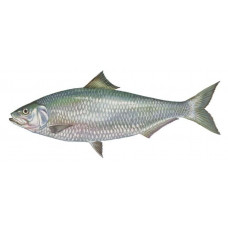Latin name
Alosa alabamae
Other names
Gulf shad, Ohio shad.
Identification
It has a large terminal mouth with upper and lower jaws of almost equal length. The tongue has one midline row of small teeth, no lateral line, and 18 anal rays. In general, it is almost identical to the larger American shad, but the adult fish has 42 to 48 gill rake at the lower end of the first gill arch.
Distribution
This species is found in the northern Gulf of Mexico, from the Mississippi Delta and Louisiana eastward to the Choctawhatchee River in Florida, also found in rivers from Iowa to Arkansas and throughout West Virginia.
Habitat
It is a school species that spends most of its life in the ocean.
Size
Can grow up to 20 inches, but is usually no more than 15 inches long.
Life history and Behavior
Fish return from the ocean to rivers and streams to spawn after maturing, dwelling in the open water of medium and large rivers. Juveniles descend into rivers in the fall.
Food and feeding habits
The feeding habits of this species at sea are unknown. The Alabama shad is an anadromous species; it does not feed during spawning migrations upriver.
Reproduction
No information
| Classification | |
| Phylum | Chordata |
| Class | Actinopterygii |
| Squad | Clupeiformes |
| Family | Clupeidae |
| Genus | Alosa |
| Species | A. alabamae |
| Features | |
| Conservation status | Near Threatened |
| Habitat | Pelagic |
| Life span, years | No information |
| Maximum body weight, kg | No information |
| Maximum length, cm | 51 |
| Sailing speed, m/s | No information |
| Threat to people | Edible |
| Way of eating | Planktonophage |

